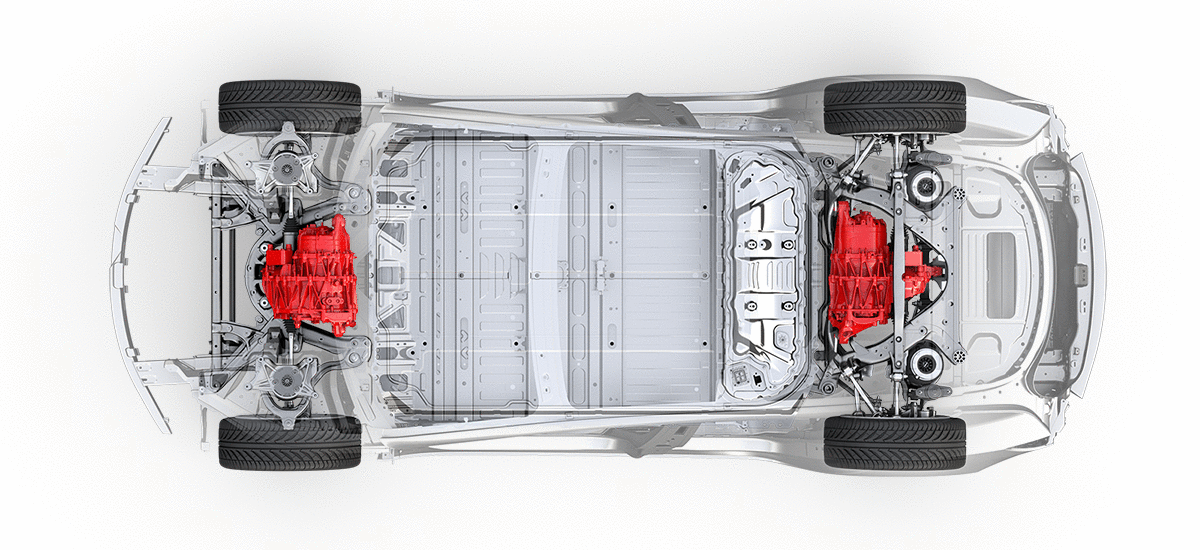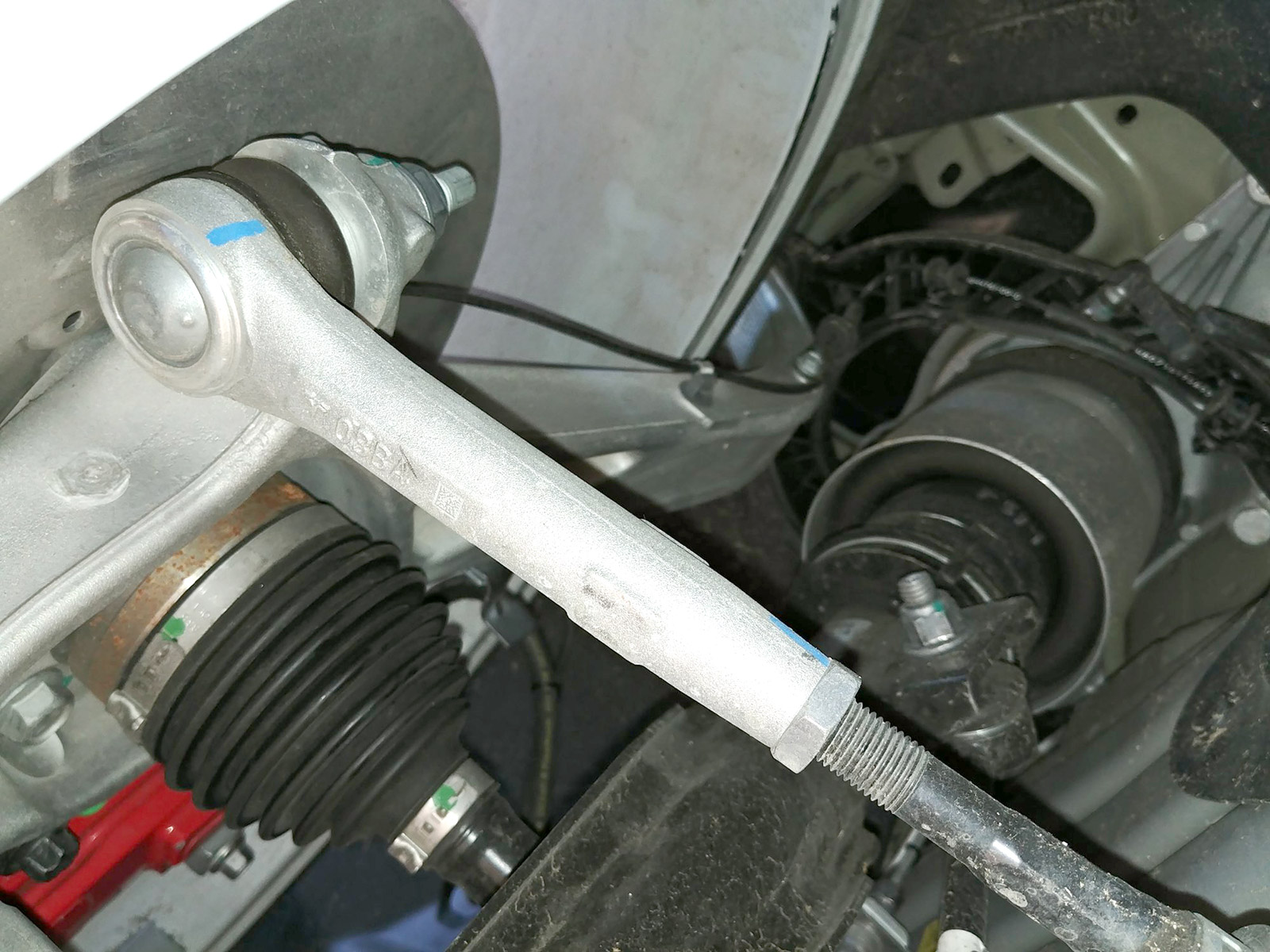
All you need to know about the Dual Motor Tesla Model 3 (All-Wheel Drive)
The concept of an All-wheel drive (AWD) which is also called 4×4, Four-wheel drive (4WD), and Quattro is as old as 1893 when a British engineer Bramah Joseph Diplock patented the first All-wheel drive system for a steam-powered traction engine.
All-wheel drive for traditional Internal Combustion Engine (ICE) vehicles works a little bit differently than the modern Electric Vehicles. ICE vehicles supply power to the rear wheels through a rear driveshaft and rear differential.
While the ICE vehicles normally don’t have two engines to enable All-wheel drive — the AWD Electric-Vehicles have two motors in the front and rear that work independently but synchronously to power all four wheels as you can see in the above Tesla Model 3 chassis image with dual motors.
In extreme cases an EV is equipped with four motors that power each wheel like the Rimac Concept_One electric hypercar and later models — this system is also called Individual Wheel Drive (IWD).
Tesla has introduced an All-wheel drive system for their next generation Roadster (2020) that is equipped with three motors (one in front, two in rear), more motors in simple words give more control over the vehicle maneuvering or enable torque vectoring.
So this was a short intro to All-wheel drive or dual-motor setup for dummies like me, now let’s get to the point and see what’s in store for us in regards to Tesla Model 3 dual motor version.
I am writing this stuff keeping in mind the people who are new to the Tesla universe and have recently opted to go for EVs and a sustainable future — and the Tesla experts and scientists can use the comments section below to pour out their valuable feedback and thoughts.
You can use the links below to jump to a specific topic of interest or keep scrolling down (credits and further reading links at the end).
- Does a Tesla Model 3 with dual motors exist?
- Identifying a dual-motor Tesla Model 3 using a VIN
- Difference between a Tesla Performance Dual-Motor (PD) and standard Dual Motor (D) setup
- When will dual-motor Tesla Model 3 be available to order?
- Possibility of converting an RWD Tesla Model 3 to a Dual-Motor config?
Existing Tesla Model 3 with Dual-Motor configuration
There have been a couple of sightings of the Dual Motor Tesla Model 3s — the very first one was found in the wild by Ryan McCaffrey the host of the Tesla podcast ‘Ride the lightning’.
The car found by Ryan was a prototype test vehicle with dual motors (all-wheel drive) and the only way it was identified as a dual-motor Model 3 was by decoding the VIN of the vehicle (check the method below).
The other one was recently spotted by TMC member ‘sreams’ about two weeks ago at the Thunderhill Raceway in Willows, CA where he had to snug his camera under the front axle and take a photo to confirm the Model 3 he’s looking at was actually a dual-motor version.

Found on the race track with dual motors and air suspension this Model 3 is most probably a performance dual motor (PD), not a non-performance dual motor config (D). He explained his experience when He saw this Tesla Model 3 as;
I’m at Thunderhill Raceway in Willows, CA for a track day today. When I arrived, there were 4 Model 3S with manufacturer plates on them. One in particular had 20″ wheels with Michelin Pilot sports, and *huge* brake rotors. I snuck my camera under the front wheel and caught a photo of the front CV axle, showing it to be dual motor. This was certainly a PD Model 3!
To date, there have been ~43 Tesla Model 3s registered with dual motor configuration by Tesla as tracked by Model 3 VIN (a Tesla enthusiast updating us on each batch of Tesla Model VINs registered by tracking them through the NHTSA website).

If the 8th digit of the VIN for a Tesla vehicle/EV is 2, 4, or B it means that the vehicle has a dual motor powertrain. Digit 4 identifies a ‘Performance’ dual-motor powertrain while 2 & B represent ‘standard’ dual motor config.
The above VIN is 5YJ3E1EB3JF008370 where the 8th digit is ‘B’ which means it’s a standard dual-motor vehicle.
Difference between Performance Dual Motor (PD) and Standard Dual Motor (D) powertrains
As we have seen with other Tesla vehicles like the Model S and Model X have non-performance Dual Motors ‘D’ versions and a performance version with dual-motor powertrain called ‘PD’ for example Model S 100D and Model S P100D.
The apparent difference between both versions is a bigger motor/drive-unit at the rear and a smaller motor at the front for the ‘Performance’ version and for the standard ‘D’ version both rear and front motors are almost similar in size.
As we can see in the featured Model 3 dual motor chassis image above (from Model 3 design studio) the rear motor is proportionally larger in size than the front motor, this indicates that the diagram is of a Performance Dual Motor Tesla Model 3.
This image also has garnered speculation that Tesla will aim to produce only Performance Dual Motor Model 3 versions at first because performance vehicles cost significantly higher than standard versions.
Performance versions of Tesla vehicles also have higher battery-pack power output to drive-units/motors but that is some complex electrical engineering we might want to discuss later sometime.
Last year Elon Musk said a Performance version of Model 3 will be coming probably mid-2018 as they slowly escape the ‘production hell’ in the following tweet;
When will Dual Motor All-wheel-drive Model 3 be available?
Thousands and maybe more Model 3 reservation holders from around the world are waiting for the AWD/Dual-Motor Model 3 to be available for order or at least be able to configure in Tesla’s online Design Studio which is currently available on an invite-only basis.
Tesla has only teased the Model 3 Dual Motor config in the design studio but the availability is mentioned as ‘mid ’18’ as we can see in this screen-shot posted by ‘u/dieabetic’ from the Tesla subreddit.
Recently Elon Musk announced on Twitter (tweet below) that manufacturing of the Dual Motor Model 3 will only start when Tesla has reached their Model 3 production goal of at least 5000/week. Elon Musk is aiming to achieve that goal by July this year, but we all know it would stretch a little more as per history lessons.
Possible conversion to a Dual Motor All-Wheel Drive Model 3 from a Rear-Wheel Drive
Actually, Tesla has made one Model 3 chassis for all — as we can see in the video below by Paul (u/ingineerix) as he tore down a Rear-wheel drive (RWD) Tesla Model 3 and found that the same car will be used to install a front drive-unit/motor.
This setup will surely help Tesla produce All-wheel-drive Model 3s faster and reduce manufacturing time — also a possibility of converting your RWD Tesla Model 3 to a Dual Motor version sometime in the future.
Credits:
Featured image: Explored by Eaer & animated by Spacex_fanny from Tesla Subreddit
Ryan McCaffrey (Ride the lightning Podcast)
‘sreams‘ from Tesla Motors Club
Further Reading:
How Four Wheel Drive works
Torque Vectoring
Four Wheel Drive/AWD/IWD/ info and history (Wikipedia)



Expert Says Tesla Model 3 Battery Pack Is Most Advanced Ever Produced
Posted at 18:00h, 27 June[…] modifications while delivering Model 3s for these regions — we have seen the same future planning for the dual motor setup where there’s no difference in RWD and AWD Model 3 […]
Tesla Model 3 Has "Most Advanced Large-Scale Lithium Battery Ever Produced," Battery Expert Notes | CleanTechnica
Posted at 14:01h, 09 July[…] modifications while delivering Model 3s for these regions — we have seen the same future planning for the dual motor setup, where there’s no difference in RWD and AWD Model 3 […]
Tesla Model 3 Has “Most Advanced Large-Scale Lithium Battery Ever Produced,” Battery Expert Notes – biznex
Posted at 17:21h, 09 July[…] modifications while delivering Model 3s for these regions — we have seen the same future planning for the dual motor setup, where there’s no difference in RWD and AWD Model 3 […]